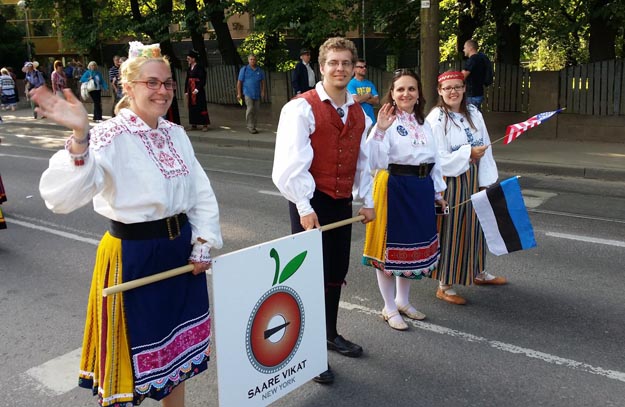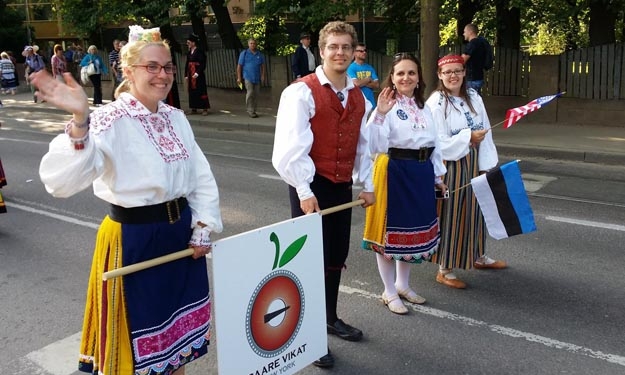 New York folk dance group Saare Vikat: Triin Lawrence, Jaan Kangro, Liisi Vanaselja and Linda Lu. Photo by Aleks Kask
New York folk dance group Saare Vikat: Triin Lawrence, Jaan Kangro, Liisi Vanaselja and Linda Lu. Photo by Aleks Kask
The Estonian national song and dance celebration took place in Tallinn on 4–6 July, 2014. A whopping 96 per cent of Estonians surveyed in a sociological study led by UT Professor of Social Communication Marju Lauristin and Senior Media Researcher Peeter Vihalemm consider the song celebration important. Moreover, two-thirds of the total 1301 respondents – a representative sample of the Estonian-speaking population aged between 15–74 – deem the celebration very important.
This is no surprise, as every second Estonian within the surveyed age range has previously been on stage in a song or dance celebration at least once. Two in three Estonians have attended such celebrations, and 90 per cent have followed them via TV or radio broadcast.
So what is the magic force driving people to the festival grounds? According to the survey, the top three incentives are: national tradition, a sense of national unity, and family members or friends performing.
The ‘Singing Nation’ is not a mere metaphor. I would say that the Song Festival Grounds gather Estonia’s biggest congregation with common sacred values. Surely, some have said that the Song Festival’s time is over. However, the survey has clearly indicated that for the majority of young and old Estonians alike, the Song Festival is a celebration where Estonian people gather to experience together our essential values, and feel that they belong to a community, a congregation. Participation in the festival is an extremely important common departure from the everyday routine towards values that bond us with the past. It is close to a religious feeling. The survey has shown that Estonians have a great need for the sacred, and it feeds upon this tradition.
UT Professor Marju Lauristin
The top 5 festival experiences
The festival programme can seem overwhelming and picking events to attend hard. If you were wondering what the must-see things would be, look no further. Here are the top five experiences as seen by Estonians themselves:
1. The festive procession
2. Lighting of the festival fire and the opening song
3. The closing song (‘Mu Isamaa’ – My Fatherland)
4. People wearing folk costumes
5. The ‘Tuljak’ dance at the end of the festival
While for many Estonians the celebration experience is one undivided whole, people seem particularly to enjoy the parts where big groups perform. So, at the song celebration the united choirs singing at the end and the beginning of the celebration are marveled at above all else. The performances of male choirs, mixed choirs, and children’s choirs come next as most liked. Rock bands and symphony orchestras are the least popular on this stage.
Similarly to song performances, the singing nation adores the final and the prologue dances where all participants are engaged.
What the celebration is and is not
Most Estonians (84 per cent of respondents) are looking for national feelings and not entertainment at the song and dance celebration. Almost as many believe that the celebration is and will remain an expression of Estonian identity, important enough to deserve state-level support also in hard times. The majority (77 per cent) sees the festival as a unique national celebration, not a tourist attraction.
As for the content, Estonians value traditions and mostly await the widely known patriotic songs so they can sing along. People are quite unanimously against including lengthy choral works, spiritual music, and songs in other languages or from other nations.
Women more engaged in the celebration
Estonian women are known to value culture more in their lives than men. The same applies for the song and dance celebration – it is a very important event for 71 per cent of women and 53 per cent of men. Highly educated people are also more engaged in the celebration.
Obviously, older people have participated in more celebrations throughout their lives, though people of all age groups have had at least some experience. The youngest respondents aged 15–19 are the most indifferent towards culture, and, worryingly, also less sure about the vitality of the national song and dance tradition.
How to engage these youngsters? Early participation in singing and dancing activities seems to be the key; however, new emerging forms of engagement can be effective as well. Students of the international master’s programme in Crossmedia Production conducted a smartmob for that purpose.
http://blog.ut.ee/the-song-festival-is-sacred-for-estonians/















